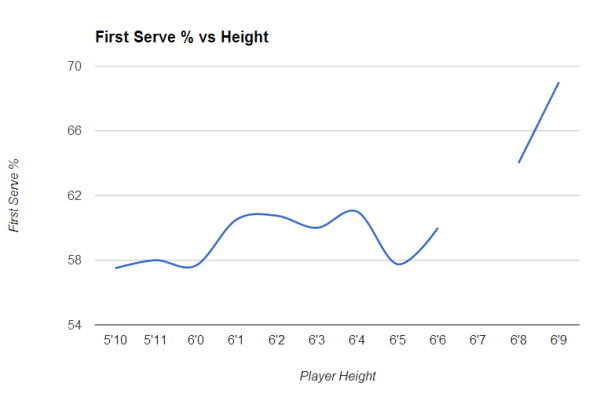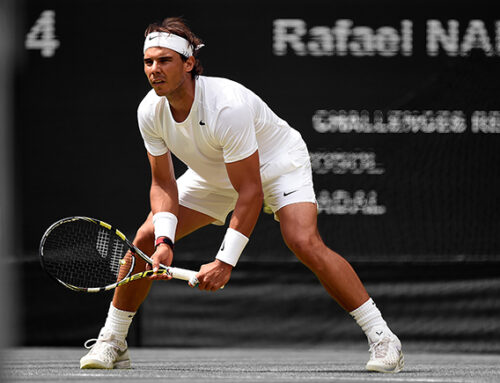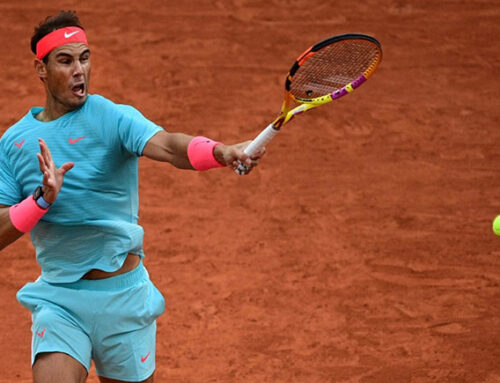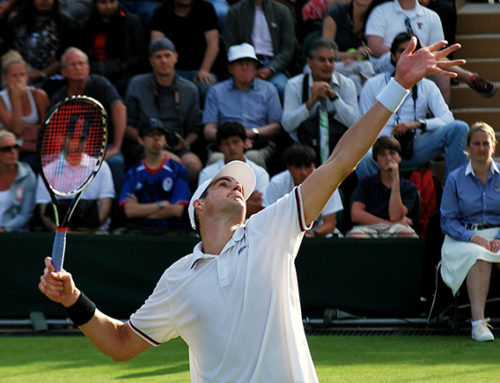As often happens here at Tactical Tennis I sat down with a specific idea – in this case that Juan Martin del Potro is a pretty sub-par server for a man of his height. While doing the research to see if my idea actually was right, I realized that there were a lot of interesting cases out there when it comes to serving and that it might merit an entire series of articles. And so we are here: height, risk vs reward and other interesting things. I thought it important to establish something of a baseline with which to examine the service motions that we will look at it future portions of this series (for example it is important that I said del Potro is a sub-par server for a man of his height). What does height really mean when it comes to serving? How can a server balance the risk vs reward when it comes to choosing their aggression level? To answer these questions I compiled a bunch of statistical data from the ATP website’s statistics on servers in the 2012 season. Since we were looking at general trends, the year itself was fairly irrelevant as long as it was reasonably recent. So without further ado…
Risk vs Reward
Before we look at height, we’re going to start with the idea of risk vs reward when it comes to serving. After all, in theory height merely alters the risk vs reward relationship and so it’s important to first establish what that relationship is. To do, we will look at a couple of key serving statistics of top players that all fall within a narrow height range. In this case, 6’0 to 6’2 tall (~182-188cm for the rest of the world). By limiting the height to a narrow range we can hopefully eliminate most of the variables related to height and get a better idea of just how risk and reward play off. But first of all, what do I mean by risk and reward? When I step up to hit a serve, I have a variety of serves available to me. Most professional players are capable of hitting serves ranging from relatively flat and very fast, to relatively slow and heavy spin. When they go to serve, they are choosing whether to go for a high risk, high reward serve (flatter and harder) vs a low risk, low reward serve (slower with heavier spin). Does this idea really play out? As it turns out, yes, yes it does! 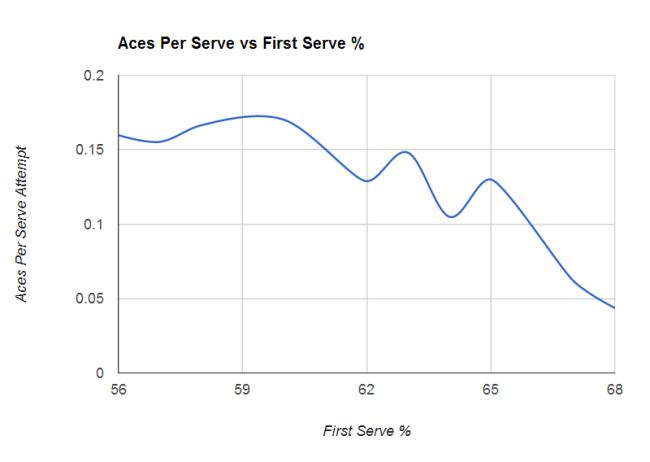
This graph shows us the Aces per first serve attempt vs first serve %. In this case I wanted to eliminate the factor of height, while still getting a reasonably statistically significant data set. So, I took all of the players in my sample that had a height between 6’0 and 6’2. The first thing that leaps out is that there is a definite downward trend. The second is that it is definitely not a straight line. And why not? First of all, not all servers are created equal. One player might have a better motion than another player, so even at the same first serve % he will serve more aces per serve attempt. These players who are unusually effective or unusually poor will skew the curve because of the limited data – I feel fairly confident that if took 50 players instead of 30 it would smooth the line out some. 1000 players would smooth it out even more. But to illuminate the concept, let’s look at the spike that occurs at 63%, otherwise known as the “Roger Federer” effect. Federer has an extremely good serve for his height, and serves comfortably more aces than other players of a similar height with a similar first serve %. Likewise the sharp dip 67% first serves is due to Rafael Nadal, who largely spins his first serve in worrying little about whether or not he hits an ace. The key take away here is that there does exist a general downward trend – the more aggressive a server becomes (ie the more they try to hit an ace or service winner), the lower their first serve % becomes. This is the aforementioned risk vs reward.
The Effect of Height
In theory, service motions being equal, a taller player should make more first serves than a shorter player. Does this hold up in practice? Generally speaking, yes! As we can see from the graph, as height goes up the first serve % goes up. There is a somewhat odd plateau that occurs from around 6′ through to 6’6. This is likely just attributable to the fact that I was able to only pull from a sample size of around 30 players. With more players we would expect the trend to be a little more clear. Suffice to say though that height and first serve % definitely seem to correlate nicely. However we can go one step further, and rather than just look at average first serve % for a given height, instead compare first serve % among different players who have a similar ace %. In theory, if two players serve aces at a similar rate, the taller player will do so with a higher first serve % than the shorter player. Does this pan out? The short answer is: yes.
Although the graph doesn’t form the smooth steadily rising curve we might have expected, there is good reason for that. The first is that we have very limited data to work with, and therefore a very small number of exceptionally good or exceptionally bad servers at a given height can really throw the curve off. A perfect example is the huge dip at 6’5 – which is essentially solely attributable to Benoit Paire (yes his serve really is comparably that bad). Also as we go to the larger heights we are working with a much smaller sample size – there are relatively few players who are 6’5 and above.
If we overlook the bumps along the road we can see that there is a very clear divide between the shorter servers and the very small servers. This might well seem an obvious statement, something we intuitively understand simply from watching tennis however is very important to establish with concrete data. By doing so, we can then use this to help identify servers who are, relatively speaking, poor servers and then examine their technique to understand why they are bad servers.
Hitting Two “First” Serves
An idea that I’ve seen talked about before and that seems to come up periodically is “why don’t the pros just hit two first serves instead of hitting a first serve and a second serve”. To begin with let’s re-phrase that in a more accurate way: “Why do pros hit a low risk/reward topspin serve for their second serve instead of playing a higher risk/reward flat or slice serve?”
It’s an interesting though, and one that bears examining. So, let’s pick out three servers from the 6’1 grouping and examine this as a possibility. The players we will use are: Roger Federer, Richard Gasquet, and Juan Monaco. I picked those three as they represent a good spread on the risk/reward spectrum with their normal first serves. So exactly how do we figure out if this is a good idea? Essentially we need to compare each player’s overall win% on their service points, and then calculate an estimate of what their overall win% would be like if they hit two aggressive serves in lieu of a topspin second serve.
Of course to do this we need to make a couple of assumptions:
1. A player’s win% on an aggressive second serve would match that of their normally aggressive first serve
2. All three players make essentially 100% of their second serves. This isn’t entirely true, but close enough for our purposes.
So let’s take a look at what it would look like:
The “Aggressive Win %” column shows us what each player’s theoretical overall win% would be on their own serve, including the double faults they hit as a result of the higher risk second serves. This was found by calculating the double fault % of each player when hitting two aggressive serves, and then removing those double faults from their overall win % for ‘first serves’. As we can see, for each of these players hitting two aggressive serves grants them a net loss on overall points won on serve. While it might seem surprising that Juan Monaco actually loses the least with this strategy, it turns out to make sense when you look at the math. Because the double fault rate when hitting two aggressive serves is related to the square of the first serve faults, Monaco serves a full 4% less double faults hitting two aggressive serves than either Federer or Gasquet.
Of course while doing this an interesting thought occurred to me: what about a player like John Isner? If it does nothing for an average height player, what about someone like Isner whose serve is so overpowering and the rest of his game is sub-par by comparison? Rather than post another table, let’s just skip to the chase and say that Isner’s normal win% is a solid 71.15%. Hitting two aggressive serves it barely drops to 70.33%. Not bad, but we can see that if it doesn’t work for Isner, it really won’t work for anyone. As such we can call this idea or myth pretty firmly debunked (at least at the pro level).
Now we have some data to work with, let’s run down our top 5 best and worst servers on the ATP Tour!
5 of the Best Servers on the ATP Tour (in no particular order)
1. Philipp Kohlschreiber
This might come as a surprise to some, but Philipp is something of a serving powerhouse all things considered. At just 5’10, he whops an ace on an excellent 15.36% of his first serves, all while maintaining a first serve % of 60%. To put it in perspective, his serving performance is on par with 6’5 Tomas Berdych, and actually exceeds that of 6’3 Andy Murray!
2. Ivan Dogig
I promise I’m not just plucking obscure names. Dogig may not typically run with the big dogs but when it comes to serving he certainly does! 6′ tall, Ivan serves a respectable 60% first serves. What makes him stand out however is bangs aces on 19.56% of his first serves. This puts him on the short list of inch for inch servers on the tour.
3. Milos Raonic
This name won’t surprise anyone, but it belongs here regardless. At 6’5 Milos has a reasonable but not outstanding 62% of first serves in play. What makes him exceptionally is the fact that fully 32.90% of them are outright aces. Think about that – virtually 1/3 of his first serves his opponents don’t even put a racket on, let alone get back in play. By comparison Isner’s ace % is ‘only’ 27.03%. Speaking of which…
4. John Isner
It’s hard to imagine a list of the best servers that doesn’t have Isner on it, and so here he is. It might well be that had we more 6’9 servers to compare him to he might actually prove a sub-par server for his height. However his 27.03% ace rate on a 69% first serve success rate makes that fairly unlikely.
5. Roger Federer
While we all know Federer to be an excellent server, it wasn’t until I compiled the data that I realize he single-handedly brought the 6’1 players a bump in their group statistics. Neither his first serve % (63%) nor his ace rate (17.08%) is exceptional, but combined they are downright excellent.
5 of the Worst Servers on the ATP Tour (in no particular order)
1. Benoit Paire
Perhaps this one is in a particular order. For his height, Paire’s serve is downright abysmal. A quick glance at his ace rate (17%) would make him seem respectable. But then your eyes catch his first serve % and you probably blink and read it again to be sure. At 51% first serves in play, Paire is a disgrace to tall servers everywhere. 5’11 Tipsarevic matches his ace rate and gets 58% of first serves in play. In fact, the list of servers that put up better numbers than Paire is.. well just about everyone.
2. Guillermo Garcia-Lopez
Garcia-Lopez stands 6’2, and manages to be not particularly good at anything related to hitting serves. His first serve % is a measly 57%. Not abysmal, but those are numbers usually put up by players hitting highly aggressive first serves with a high ace rate. Garcia-Lopez does not fall into that category. He hits aces only 7.78% of the time, among the worst of players for whom data was collated.
3. Alexandr Dolgopolov
The Dog was a surprise addition to the list, but the numbers bear out. Alexandr makes only 54% of his first serves, while hitting aces on only 5.69% of them. Those are paltry numbers, and his short stature (5’11) is the only thing that cuts him even a little slack.
4. Albert Ramos
If I want to learn to serve, I’m probably not going to Spain to do it! Joining Garcia-Lopez is Ramos, who manages to be mediocre in both first serve % (57%) and ace rate (7.78%). If he were shorter than his 6’2 height then it might be excusable, but he should at least be good at something.
5. Pablo Andujar
When you’re serving aces on only 3.45% of your attempts, you better at least be getting a lot of them in. Not so with poor Pablo. While other low acers have much higher first serve % (Davydenko makes 70% of his first serves, Fognini makes 65%), Andujar gets only 58% of his first serves in play despite being an inch taller.
So what comes next? Well, we will take a look at some of these servers in detail, examine their technique and see exactly why they are particularly good or bad. In doing so perhaps we can help readers understand a little about their own serves, and maybe even improve a little!
